大学英语词汇教学实践论文
- 格式:doc
- 大小:24.50 KB
- 文档页数:5
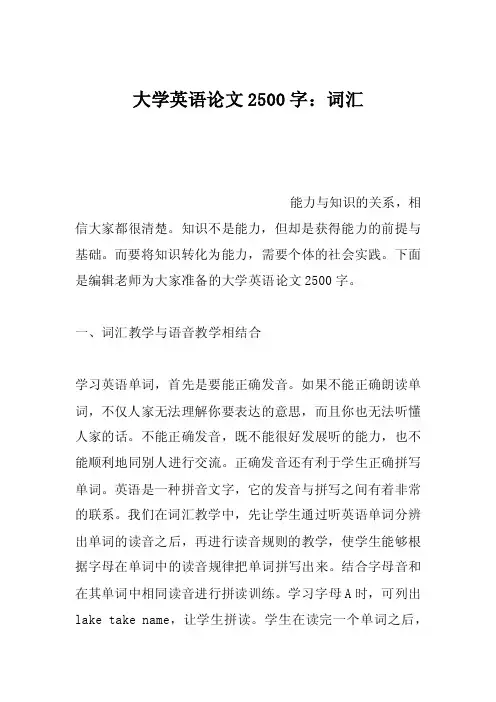
大学英语论文2500字:词汇能力与知识的关系,相信大家都很清楚。
知识不是能力,但却是获得能力的前提与基础。
而要将知识转化为能力,需要个体的社会实践。
下面是编辑老师为大家准备的大学英语论文2500字。
一、词汇教学与语音教学相结合学习英语单词,首先是要能正确发音。
如果不能正确朗读单词,不仅人家无法理解你要表达的意思,而且你也无法听懂人家的话。
不能正确发音,既不能很好发展听的能力,也不能顺利地同别人进行交流。
正确发音还有利于学生正确拼写单词。
英语是一种拼音文字,它的发音与拼写之间有着非常的联系。
我们在词汇教学中,先让学生通过听英语单词分辨出单词的读音之后,再进行读音规则的教学,使学生能够根据字母在单词中的读音规律把单词拼写出来。
结合字母音和在其单词中相同读音进行拼读训练。
学习字母A时,可列出lake take name,让学生拼读。
学生在读完一个单词之后,可将辅音变换进行替换练习,如将lake中的“l”替换成b,c,d,f,g ,h,j,m,n,p,r,s,t,以培养学生的拼读能力。
采用类推方式。
如学生已学过farm,在学习,bark,mark这些词时,先让学生复习farm,然后让学生尝试读bark,mark 这些词。
让学生归类。
可让学生对同一字母或字母组合在不同单词中的读音进行归类。
这就解决了学生掌握词汇的一个很重要的问题 --拼写单词。
使学生掌握单词中字母及组合的读音规律,能够做到听词能写, 见词会读。
二、融构词法于词汇教学之中英语是一种适应性和灵活性很强的语言。
在其总词汇量中,除了数量很少的基础词汇是本族语外,大部分词汇是在借用拉丁语词根和希腊语词根的基础上加以英化的。
在课堂的教学中,我们要求学生熟记一些词根。
根据词缀在新词中不同位置,可分为前缀和后缀两种。
前缀改变原词的意思,但通常不改变原词的词性;后缀加在词干的末尾,改变原词的意思,并且在很多情况下改变原词的词性。
借助前缀、后缀、[作者简介] 郭丽杰 (1963- ),女,副教授,研究方向:大学英语教学。
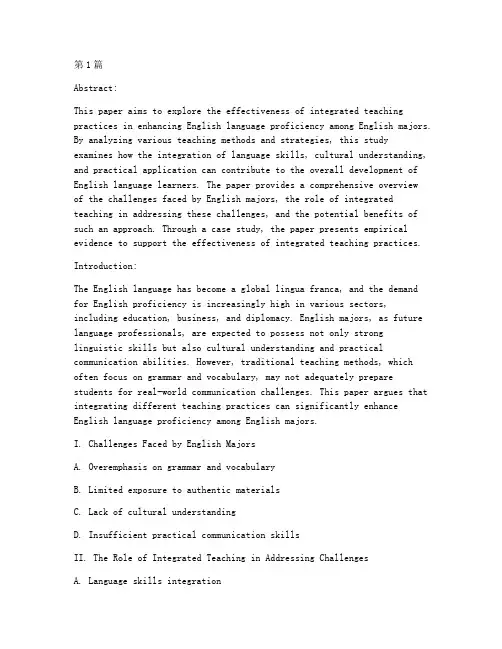
第1篇Abstract:This paper aims to explore the effectiveness of integrated teaching practices in enhancing English language proficiency among English majors. By analyzing various teaching methods and strategies, this study examines how the integration of language skills, cultural understanding, and practical application can contribute to the overall development of English language learners. The paper provides a comprehensive overviewof the challenges faced by English majors, the role of integrated teaching in addressing these challenges, and the potential benefits of such an approach. Through a case study, the paper presents empirical evidence to support the effectiveness of integrated teaching practices.Introduction:The English language has become a global lingua franca, and the demandfor English proficiency is increasingly high in various sectors,including education, business, and diplomacy. English majors, as future language professionals, are expected to possess not only stronglinguistic skills but also cultural understanding and practical communication abilities. However, traditional teaching methods, which often focus on grammar and vocabulary, may not adequately prepare students for real-world communication challenges. This paper argues that integrating different teaching practices can significantly enhance English language proficiency among English majors.I. Challenges Faced by English MajorsA. Overemphasis on grammar and vocabularyB. Limited exposure to authentic materialsC. Lack of cultural understandingD. Insufficient practical communication skillsII. The Role of Integrated Teaching in Addressing ChallengesA. Language skills integration1. Reading, writing, listening, and speaking2. Task-based language teachingB. Cultural understanding1. Cultural awareness and sensitivity2. Cultural competenceC. Practical application1. Real-life scenarios2. Collaborative learningIII. Benefits of Integrated Teaching PracticesA. Enhanced language proficiencyB. Improved cultural understandingC. Increased motivation and engagementD. Preparation for real-world communication challengesIV. Case Study: An Integrated Teaching Approach in an English Major ProgramA. MethodologyB. ResultsC. DiscussionV. ConclusionI. Challenges Faced by English MajorsEnglish majors often encounter several challenges in their language learning journey. One of the primary challenges is the overemphasis on grammar and vocabulary, which may hinder their ability to communicate effectively in real-life situations. Additionally, limited exposure to authentic materials, such as native speakers' conversations andcontemporary texts, may restrict their language acquisition. Furthermore, the lack of cultural understanding can lead to miscommunication and a superficial understanding of the language and its users. Lastly, insufficient practical communication skills may prevent English majors from applying their knowledge in real-world scenarios.II. The Role of Integrated Teaching in Addressing ChallengesTo address these challenges, integrated teaching practices can play a crucial role. By integrating different teaching methods and strategies, English majors can develop a well-rounded skill set that encompasses language skills, cultural understanding, and practical application.A. Language skills integrationIntegrating reading, writing, listening, and speaking skills allows English majors to develop a comprehensive understanding of the language. Task-based language teaching (TBLT) is an effective approach that encourages students to engage in real-life communication tasks,fostering the development of all language skills simultaneously.B. Cultural understandingCultural understanding is essential for effective communication. By promoting cultural awareness and sensitivity, English majors can avoid cultural misunderstandings and develop cultural competence, which is crucial for interacting with diverse groups of people.C. Practical applicationPractical application is vital for the development of communication skills. By incorporating real-life scenarios and collaborative learning activities, English majors can practice their language skills in a supportive environment and prepare for future communication challenges.III. Benefits of Integrated Teaching PracticesIntegrated teaching practices offer several benefits for English majors:A. Enhanced language proficiencyBy integrating different teaching methods, English majors can develop a more comprehensive understanding of the language, leading to enhanced language proficiency.B. Improved cultural understandingCultural understanding is crucial for effective communication. Integrated teaching practices can help English majors develop cultural awareness and sensitivity, which is essential for interacting with diverse groups of people.C. Increased motivation and engagementAn integrated approach to teaching can increase students' motivation and engagement by providing a variety of learning experiences and making the learning process more enjoyable and relevant.D. Preparation for real-world communication challengesIntegrated teaching practices can prepare English majors for real-world communication challenges by equipping them with the necessary skills and knowledge to navigate diverse cultural contexts and communication scenarios.IV. Case Study: An Integrated Teaching Approach in an English Major ProgramThis section presents a case study of an integrated teaching approach implemented in an English major program. The study involves a group of 30 English majors who were taught using a combination of language skills integration, cultural understanding, and practical application.A. MethodologyThe study employed a mixed-methods approach, including surveys, interviews, and observations. Data were collected to assess the effectiveness of the integrated teaching approach in enhancing language proficiency and cultural understanding.B. ResultsThe results indicated that the integrated teaching approachsignificantly improved the language proficiency and cultural understanding of the English majors. Students reported higher levels of engagement and motivation, as well as an increased ability to communicate effectively in diverse cultural contexts.C. DiscussionThe findings of the case study support the effectiveness of integrated teaching practices in enhancing English language proficiency among English majors. The study highlights the importance of integrating language skills, cultural understanding, and practical application in the teaching of English.V. ConclusionIn conclusion, integrated teaching practices can significantly enhance English language proficiency among English majors. By addressing the challenges faced by students and incorporating a variety of teaching methods, English majors can develop a well-rounded skill set that prepares them for real-world communication challenges. This paper has demonstrated the effectiveness of integrated teaching practices through a case study and provides a comprehensive overview of the benefits of such an approach. As language professionals, English majors should be equipped with the necessary skills and knowledge to thrive in a globalized world, and integrated teaching practices can play a vital role in achieving this goal.第2篇Abstract:This paper presents a case study of an English language teaching practice implemented in a higher education setting. The study explores the effectiveness of integrating various teaching methods and technologies to enhance students' English language proficiency. Through the analysis of student performance, teacher reflections, and feedback from the students, the paper evaluates the outcomes of the integratedteaching approach and provides insights into the challenges and benefits of implementing such strategies in the English language classroom.Introduction:The demand for English language proficiency has surged globally, with English becoming the lingua franca in various domains such as business, science, and technology. In higher education, English language courses play a crucial role in preparing students for international communication and academic pursuits. However, traditional teaching methods often struggle to keep up with the dynamic nature of language learning and the diverse needs of students. This paper aims to investigate the effectiveness of an integrated teaching approach that combines various methods and technologies to enhance English language proficiency in a university setting.Literature Review:Previous research has highlighted the importance of integratingdifferent teaching methods to cater to diverse learning styles and enhance language acquisition. Some studies have shown that a combination of communicative, task-based, and technology-assisted language learning approaches can significantly improve students' language skills (Harmer, 2007; Nunan, 1991). Additionally, the use of technology in language learning has been found to promote autonomy, motivation, and engagement (Richards & Rodgers, 2001).Methodology:The study was conducted in a public university in China, involving a sample of 50 English language students enrolled in an intermediate-level course. The participants were divided into two groups: an experimental group that received integrated teaching and a control group that followed the traditional teaching method. The integrated teaching approach included the following components:1. Communicative language teaching (CLT): Focus on interaction and communication through pair and group work activities.2. Task-based language learning (TBL): Use of authentic tasks that require students to use English in real-life contexts.3. Technology-assisted language learning (TALL): Incorporation ofdigital tools such as online platforms, multimedia resources, and educational apps.4. Flipped classroom: Students engage with online content outside the classroom, allowing for more interactive and personalized learning during class time.Data collection methods included pre- and post-tests to measurestudents' language proficiency, teacher reflections on the implementation of the integrated approach, and student feedback on their learning experiences. The data were analyzed using descriptivestatistics and content analysis.Results:The results of the study indicated that the experimental group, which received integrated teaching, demonstrated significant improvements in their English language proficiency compared to the control group. The post-test scores of the experimental group were higher than those of the control group in all areas assessed, including listening, speaking, reading, and writing. Teacher reflections highlighted the positive impact of the integrated approach on student engagement and motivation, as well as the challenges of managing diverse learning needs and technology integration.Student feedback revealed that the integrated teaching approach was effective in enhancing their language skills and promoting a more dynamic and interactive learning environment. Students particularly appreciated the use of technology, which allowed them to access resources and practice language skills outside the classroom.Discussion:The findings of this study support the effectiveness of an integrated teaching approach in enhancing English language proficiency. Thecombination of communicative, task-based, and technology-assisted language learning methods provides a comprehensive and engaging learning experience that caters to diverse learning styles and needs. The use of technology not only facilitates language learning but also encourages autonomy and self-regulation.However, the study also identified several challenges associated with implementing an integrated teaching approach. Teacher training and support are essential to ensure the effective use of technology and to address the diverse needs of students. Additionally, the availability of resources and infrastructure can be limiting factors in some settings.Conclusion:This case study demonstrates the potential of an integrated teaching approach in enhancing English language proficiency in higher education. The findings suggest that combining various teaching methods and technologies can lead to significant improvements in students' language skills and learning experiences. However, the successful implementation of such an approach requires careful planning, ongoing teacher development, and adequate resources. Future research should explore the long-term effects of integrated teaching practices and the beststrategies for scaling up such initiatives in diverse educational settings.References:Harmer, J. (2007). The practice of English language teaching (4th ed.). Essex: Pearson Education Limited.Nunan, D. (1991). Language teaching methodology: A textbook for teachers. Hertfordshire: Prentice Hall International.Richards, J. C., & Rodgers, T. S. (2001). Approaches and methods in language teaching (2nd ed.). Cambridge: Cambridge University Press.第3篇Abstract:This paper presents a case study on the effectiveness of integrative teaching practices in an English major program. Through a comprehensive analysis of the teaching methods, curriculum design, and student outcomes, this study aims to explore how an integrative approach can enhance English language proficiency. The paper is structured into three main sections: an introduction, a literature review, and a discussion of the findings. The conclusion summarizes the key insights andimplications for English language teaching.Introduction:The English language has become a global lingua franca, and proficiency in English is essential for academic, professional, and personal development. In response to this demand, English major programs have been developed worldwide. However, traditional teaching methods, which often focus on language skills in isolation, have been criticized for their limitations in fostering genuine language proficiency. This paper investigates the impact of integrative teaching practices on English language proficiency in an English major program.Literature Review:1. Integrative Teaching ApproachIntegrative teaching, as defined by Nation (2001), involves the combination of language skills, such as reading, writing, listening, and speaking, in a holistic manner. This approach emphasizes the interconnectedness of language skills and encourages learners to engage with the language in a meaningful and contextually relevant way.2. Benefits of Integrative TeachingResearch has shown that integrative teaching practices can lead to several benefits, including improved language proficiency, increased motivation, and enhanced critical thinking skills (Johnson & Johnson, 1989; Nation, 2001). Additionally, integrative teaching allows for a more authentic learning experience, as learners are exposed to a variety of language contexts and tasks.3. Curriculum DesignCurriculum design plays a crucial role in the implementation of integrative teaching practices. A well-designed curriculum should include a diverse range of activities that promote language skill integration, such as collaborative projects, cross-disciplinary courses, and real-world language tasks (Richards & Rodgers, 2001).Discussion of Findings:1. Teaching MethodsIn the English major program under study, a variety of teaching methods were employed to foster integrative language learning. These included project-based learning, collaborative tasks, and the use of technology. For instance, students were encouraged to work in groups to research and present on a topic related to their major, thereby enhancing their reading, writing, speaking, and listening skills.2. Curriculum DesignThe curriculum in the English major program was designed to promote integrative language learning. It included courses such as English for Specific Purposes (ESP), English for Academic Purposes (EAP), and cross-cultural communication. These courses aimed to prepare students for various real-world language demands, such as academic writing, professional communication, and cultural understanding.3. Student OutcomesThe study revealed that students who engaged in integrative teaching practices showed significant improvements in their English language proficiency. Specifically, students demonstrated higher scores in standardized language tests, such as the Test of English as a Foreign Language (TOEFL) and the International English Language Testing System (IELTS). Moreover, students reported increased confidence in their language abilities and a greater appreciation for the interconnectedness of language skills.Conclusion:This case study has demonstrated that integrative teaching practices can effectively enhance English language proficiency in an English major program. By combining language skills, employing a diverse range of teaching methods, and designing a curriculum that promotes integrative language learning, English language teachers can help students achieve a more authentic and comprehensive understanding of the language. The findings of this study have implications for English language teaching, suggesting that integrative approaches should be prioritized in curriculum design and classroom practice.References:Johnson, D. W., & Johnson, R. T. (1989). Cooperation and competition: Theory and research. Edina, MN: Interaction Book Co.Nation, I. (2001). Language curriculum design. New York: Routledge.Richards, J. C., & Rodgers, T. S. (2001). Approaches and methods in language teaching (2nd ed.). Cambridge: Cambridge University Press.。
![英语词汇学的论文怎么写[共5篇]](https://uimg.taocdn.com/6ecb7b3191c69ec3d5bbfd0a79563c1ec5dad7fa.webp)
英语词汇学的论文怎么写[共5篇]第一篇:英语词汇学的论文怎么写英语词汇学的论文怎么写?英语词汇学习在英语词汇学习过程中,学习者要遵循第二语言习得的规律,掌握并灵活运用多种词汇学习策略。
可分为词汇表策略、语境策略、精加工策略、语义场策略。
一.词汇表策略(Word list strategy)词汇表策略一般为:一列是按字母顺序排列的英语单词,另一列是这些单词的汉语意思(等值词、同义词或近义词)。
有些学者认为,通过词汇表策略能够迅速且有效地学会大量的词汇。
然而,Gaims 和Redman 却指出,通过词汇表记忆词汇会阻碍对所记词汇进行充分地处理和系统地组织,因此就失去了有效的长时记忆的基础。
语言大师桂诗春教授也认为,词汇表策略既费时又费力,徒劳无功,因为这种做法不仅把外语的词语和母语的词语等同起来,而且把它从语言和语境中孤立出来。
二.语境策略(Context strategy)语境策略就是学习者通过上下文语言环境所提供的信息对出现在语境中的生词进行猜测,从而习得这个单词。
语境策略是目前比较流行的词汇学习策略之一,它不仅仅可以扩大词汇量,而且可以让学生了解有关目的语的文化知识。
但是,Channell(Carter &McCarthy ,1988:89)认为,音节认知和重音认知对学习者理解词汇起着非常重要的作用。
为了更好地理解词汇,学习新单词的方法应使学习者准确地内化和吸收新单词:即学会单个音标的发音、了解音节数、掌握重音位置。
从这一方面来看,运用语境策略学习词汇不能算是一个很好的方法。
三.精加工策略(Elaborative strategy)精加工策略是指通过对学习材料进行深入细致的分析、加工,理解其内在的深层意义并促进记忆的一种策略。
皮连生(1998)在《学与教的心理学》一书中也曾提到:“精细加工策略”(同“精加工策略”)指对学习材料作精细的加工活动,即通过在要记忆的材料上增加相关的信息来达到对新的材料记忆的学习方法。
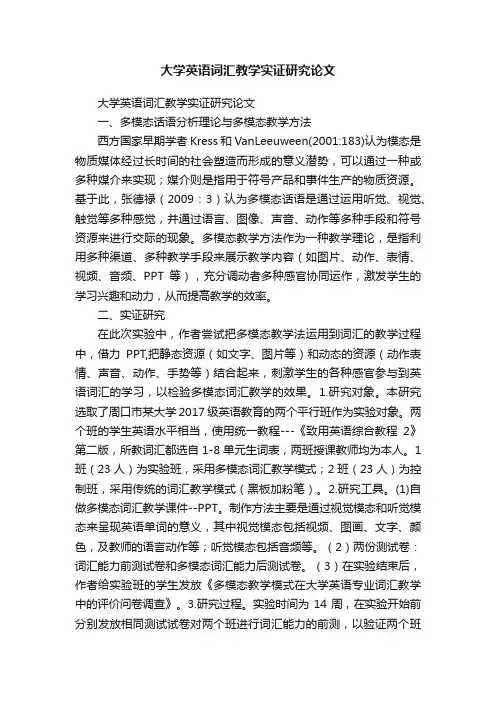
大学英语词汇教学实证研究论文大学英语词汇教学实证研究论文一、多模态话语分析理论与多模态教学方法西方国家早期学者Kress和VanLeeuween(2001:183)认为模态是物质媒体经过长时间的社会塑造而形成的意义潜势,可以通过一种或多种媒介来实现;媒介则是指用于符号产品和事件生产的物质资源。
基于此,张德禄(2009:3)认为多模态话语是通过运用听觉、视觉、触觉等多种感觉,并通过语言、图像、声音、动作等多种手段和符号资源来进行交际的现象。
多模态教学方法作为一种教学理论,是指利用多种渠道、多种教学手段来展示教学内容(如图片、动作、表情、视频、音频、PPT等),充分调动者多种感官协同运作,激发学生的学习兴趣和动力,从而提高教学的效率。
二、实证研究在此次实验中,作者尝试把多模态教学法运用到词汇的教学过程中,借力PPT,把静态资源(如文字、图片等)和动态的资源(动作表情、声音、动作、手势等)结合起来,刺激学生的各种感官参与到英语词汇的学习,以检验多模态词汇教学的效果。
1.研究对象。
本研究选取了周口市某大学2017级英语教育的两个平行班作为实验对象。
两个班的学生英语水平相当,使用统一教程---《致用英语综合教程2》第二版,所教词汇都选自1-8单元生词表,两班授课教师均为本人。
1班(23人)为实验班,采用多模态词汇教学模式;2班(23人)为控制班,采用传统的词汇教学模式(黑板加粉笔)。
2.研究工具。
(1)自做多模态词汇教学课件--PPT。
制作方法主要是通过视觉模态和听觉模态来呈现英语单词的意义,其中视觉模态包括视频、图画、文字、颜色,及教师的语言动作等;听觉模态包括音频等。
(2)两份测试卷:词汇能力前测试卷和多模态词汇能力后测试卷。
(3)在实验结束后,作者给实验班的学生发放《多模态教学模式在大学英语专业词汇教学中的评价问卷调查》。
3.研究过程。
实验时间为14周,在实验开始前分别发放相同测试试卷对两个班进行词汇能力的前测,以验证两个班的词汇水平是否处在同一水平上。
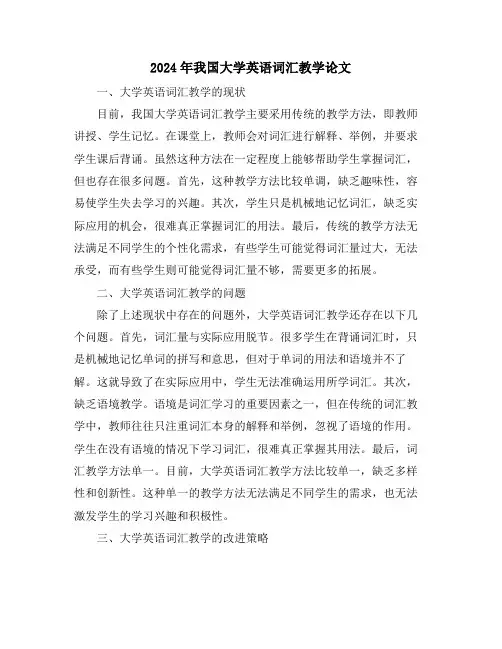
2024年我国大学英语词汇教学论文一、大学英语词汇教学的现状目前,我国大学英语词汇教学主要采用传统的教学方法,即教师讲授、学生记忆。
在课堂上,教师会对词汇进行解释、举例,并要求学生课后背诵。
虽然这种方法在一定程度上能够帮助学生掌握词汇,但也存在很多问题。
首先,这种教学方法比较单调,缺乏趣味性,容易使学生失去学习的兴趣。
其次,学生只是机械地记忆词汇,缺乏实际应用的机会,很难真正掌握词汇的用法。
最后,传统的教学方法无法满足不同学生的个性化需求,有些学生可能觉得词汇量过大,无法承受,而有些学生则可能觉得词汇量不够,需要更多的拓展。
二、大学英语词汇教学的问题除了上述现状中存在的问题外,大学英语词汇教学还存在以下几个问题。
首先,词汇量与实际应用脱节。
很多学生在背诵词汇时,只是机械地记忆单词的拼写和意思,但对于单词的用法和语境并不了解。
这就导致了在实际应用中,学生无法准确运用所学词汇。
其次,缺乏语境教学。
语境是词汇学习的重要因素之一,但在传统的词汇教学中,教师往往只注重词汇本身的解释和举例,忽视了语境的作用。
学生在没有语境的情况下学习词汇,很难真正掌握其用法。
最后,词汇教学方法单一。
目前,大学英语词汇教学方法比较单一,缺乏多样性和创新性。
这种单一的教学方法无法满足不同学生的需求,也无法激发学生的学习兴趣和积极性。
三、大学英语词汇教学的改进策略针对以上问题,本文提出以下改进策略。
首先,加强词汇应用训练。
教师应该注重词汇的实际应用训练,让学生在语境中学习词汇,了解词汇的用法和语境。
同时,教师还可以通过组织小组讨论、写作等活动,为学生提供更多的实践机会,让学生在实际应用中巩固所学词汇。
其次,引入语境教学。
语境教学是一种有效的教学方法,可以帮助学生更好地掌握词汇。
在教学中,教师应该注重语境的创设,让学生在语境中学习词汇,了解词汇的用法和语境。
同时,教师还可以利用多媒体等教学工具,为学生创造更加真实的语境,提高词汇教学的效果。
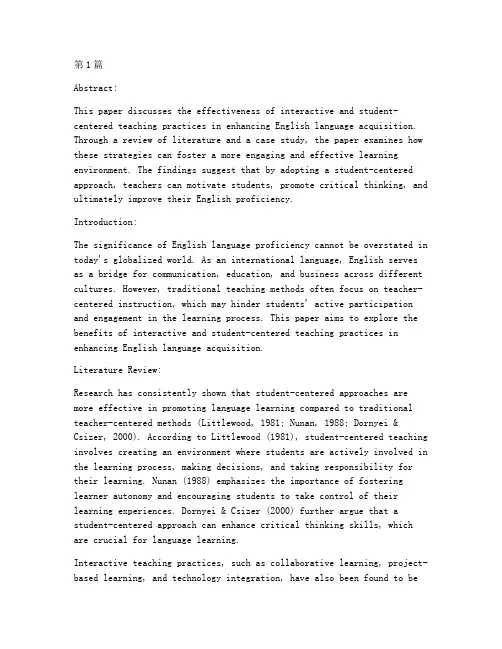
第1篇Abstract:This paper discusses the effectiveness of interactive and student-centered teaching practices in enhancing English language acquisition. Through a review of literature and a case study, the paper examines how these strategies can foster a more engaging and effective learning environment. The findings suggest that by adopting a student-centered approach, teachers can motivate students, promote critical thinking, and ultimately improve their English proficiency.Introduction:The significance of English language proficiency cannot be overstated in today's globalized world. As an international language, English serves as a bridge for communication, education, and business across different cultures. However, traditional teaching methods often focus on teacher-centered instruction, which may hinder students' active participation and engagement in the learning process. This paper aims to explore the benefits of interactive and student-centered teaching practices in enhancing English language acquisition.Literature Review:Research has consistently shown that student-centered approaches are more effective in promoting language learning compared to traditional teacher-centered methods (Littlewood, 1981; Nunan, 1988; Dornyei & Csizer, 2000). According to Littlewood (1981), student-centered teaching involves creating an environment where students are actively involved in the learning process, making decisions, and taking responsibility for their learning. Nunan (1988) emphasizes the importance of fostering learner autonomy and encouraging students to take control of their learning experiences. Dornyei & Csizer (2000) further argue that a student-centered approach can enhance critical thinking skills, which are crucial for language learning.Interactive teaching practices, such as collaborative learning, project-based learning, and technology integration, have also been found to bebeneficial for language acquisition (Harmer, 2007; Brown, 2007). Harmer (2007) suggests that collaborative learning can help students develop their social skills and improve their language proficiency through peer interaction. Brown (2007) highlights the role of technology in facilitating communication and providing students with authentic language experiences.Case Study:To illustrate the effectiveness of interactive and student-centered teaching practices, this paper presents a case study of a secondary school English language classroom. The study involved an intervention program that implemented a variety of strategies, including collaborative learning, project-based learning, and technology integration.The intervention program was conducted over a period of three months, during which the teacher observed significant improvements in the students' engagement and performance. Students were divided into small groups, and each group was assigned a project related to a specific topic. The projects required students to research, plan, and present their findings to the class. This approach not only encouraged students to work collaboratively but also motivated them to use English in real-life contexts.The teacher also incorporated technology into the classroom by using educational apps and online resources. Students were encouraged to engage with authentic materials, such as news articles, videos, and podcasts, which helped them develop their listening and reading skills. Additionally, the teacher facilitated discussions and debates, allowing students to practice their speaking and writing skills in a supportive environment.Results:The results of the case study indicate that the implementation of interactive and student-centered teaching practices had a positive impact on the students' English language acquisition. Students reportedincreased engagement and enjoyment in the learning process, which translated into higher achievement scores. The teacher observed that students were more confident in using English and demonstrated improved critical thinking skills.Conclusion:This paper has demonstrated the effectiveness of interactive andstudent-centered teaching practices in enhancing English language acquisition. By adopting a student-centered approach, teachers canfoster a more engaging and effective learning environment, promoting student motivation, critical thinking, and overall language proficiency. The case study presented in this paper provides evidence of the positive outcomes associated with these strategies. Therefore, it is recommended that educators incorporate interactive and student-centered teaching practices into their English language classrooms to enhance their students' language learning experiences.References:Brown, H. D. (2007). Principles of language learning and teaching (5th ed.). New York: Pearson Education.Dornyei, Z., & Csizer, K. (2000). Teaching and researching: A practical guide to designing courses and teaching in language teaching. Harlow: Pearson Education.Harmer, J. (2007). The practice of English language teaching (4th ed.). Essex: Pearson Education.Littlewood, W. (1981). Communicative language teaching: An introduction. Cambridge: Cambridge University Press.Nunan, D. (1988). The design and evaluation of language courses. Cambridge: Cambridge University Press.第2篇Abstract:This paper presents a case study of an English teaching practice implemented in a secondary school in China. The study focuses on the effectiveness of interactive and collaborative learning strategies in enhancing students' English language acquisition. The paper discusses the theoretical framework underpinning these strategies, the implementation process, the challenges encountered, and the outcomes achieved. The findings suggest that interactive and collaborative learning approaches can significantly improve students' engagement, motivation, and language proficiency.Keywords: English teaching practice, interactive learning, collaborative learning, language acquisition, student engagement1. Introduction1.1 BackgroundThe English language has become an essential skill in today's globalized world. In China, the importance of English proficiency has been recognized, and the government has implemented various policies to promote English language education. However, traditional teaching methods, which often focus on teacher-centered instruction, have been criticized for their limited effectiveness in fostering students' language skills. This paper aims to explore the potential of interactive and collaborative learning strategies in enhancing English language acquisition among secondary school students in China.1.2 PurposeThe purpose of this study is to investigate the impact of interactive and collaborative learning strategies on students' English language acquisition in a secondary school setting. The study seeks to answer the following research questions:1. How do interactive and collaborative learning strategies affect students' engagement and motivation in English language learning?2. What are the challenges faced by teachers and students in implementing these strategies?3. What are the outcomes of using interactive and collaborative learning strategies in English language teaching?2. Theoretical Framework2.1 Interactive LearningInteractive learning is a pedagogical approach that emphasizes student participation and active engagement in the learning process. It encourages students to interact with each other and with the teacher, promoting deeper understanding and knowledge construction (Biggs & Tang, 2007). Key elements of interactive learning include student-to-student interaction, teacher-student interaction, and self-reflection.2.2 Collaborative LearningCollaborative learning is a method where students work together in small groups to achieve a common goal. This approach promotes communication, cooperation, and mutual support among students (Johnson & Johnson, 1999). Collaborative learning can enhance students' critical thinking, problem-solving skills, and language proficiency.3. Methodology3.1 ParticipantsThe study involved 60 students from a secondary school in China, who were divided into two groups: the experimental group (30 students) and the control group (30 students). The experimental group received interactive and collaborative learning strategies, while the control group followed the traditional teaching method.3.2 InstrumentsData were collected through a pre-test and post-test to measurestudents' English language proficiency, as well as throughquestionnaires and interviews to gather information about students' engagement, motivation, and challenges faced in the learning process.4. Results4.1 Engagement and MotivationThe results showed that students in the experimental group reported higher levels of engagement and motivation in English language learning compared to the control group. This was attributed to the interactive and collaborative learning strategies that allowed students to actively participate in the learning process and collaborate with their peers.4.2 Language ProficiencyThe post-test results indicated that students in the experimental group demonstrated significant improvements in English language proficiency compared to the control group. This suggests that interactive and collaborative learning strategies can effectively enhance students' language skills.4.3 ChallengesThe study identified several challenges faced by teachers and students in implementing interactive and collaborative learning strategies. These challenges include time constraints, classroom management, and students' varying levels of English proficiency.5. Discussion5.1 The Impact of Interactive and Collaborative Learning StrategiesThe findings of this study support the notion that interactive and collaborative learning strategies can significantly enhance students' English language acquisition. These strategies promote active learning, foster a positive learning environment, and encourage students to take ownership of their learning process.5.2 Challenges and SolutionsDespite the potential benefits of interactive and collaborative learning strategies, challenges such as time constraints and classroom management can hinder their implementation. To address these challenges, teachers can adopt a structured approach to planning and implementing thesestrategies, and provide training to improve their classroom management skills.6. ConclusionThis study demonstrates the effectiveness of interactive and collaborative learning strategies in enhancing English language acquisition among secondary school students in China. The findings suggest that incorporating these strategies into English language teaching can lead to improved student engagement, motivation, and language proficiency. However, it is essential for teachers to address the challenges associated with implementing these strategies to maximize their benefits.References:Biggs, J., & Tang, C. (2007). Teaching for quality learning at university. Open University Press.Johnson, D. W., & Johnson, R. T. (1999). Learning together and alone: Cooperative, competitive, and individualistic learning (5th ed.). Allyn & Bacon.第3篇Abstract:This paper explores the effectiveness of interactive teaching strategies in enhancing English language acquisition among students. Through a case study conducted in a secondary school, the paper analyzes the implementation of various interactive techniques and their impact on students' learning outcomes. The study concludes that interactive teaching methods, such as group work, role-playing, and technology integration, significantly improve students' engagement, motivation, and overall language proficiency.Introduction:The English language has become an essential skill in today's globalized world. As such, the importance of effective English language teachinghas increased significantly. Traditional teaching methods often focus on the transmission of knowledge, with limited interaction between the teacher and students. However, recent research suggests that interactive teaching strategies can lead to better learning outcomes in language acquisition. This paper aims to investigate the impact of interactive teaching strategies on English language learning in a secondary school setting.Methodology:A case study approach was employed to investigate the effectiveness of interactive teaching strategies in a secondary school in India. The study involved 50 students from the 9th grade, who were divided into two groups: the experimental group and the control group. The experimental group received interactive teaching methods, while the control group followed the traditional teaching approach.The interactive teaching strategies implemented in the experimental group included:1. Group work: Students were divided into small groups to complete various tasks, such as discussions, debates, and presentations.2. Role-playing: Students engaged in role-playing activities to practice speaking and listening skills.3. Technology integration: The use of multimedia tools, such as videos, audio clips, and interactive whiteboards, was incorporated into the lessons.4. Inquiry-based learning: Students were encouraged to ask questions, conduct research, and share their findings with the class.Data collection was done through pre- and post-tests, observation of classroom activities, and interviews with both students and teachers. The pre-test and post-test results were analyzed using descriptive statistics, while the interviews were coded and analyzed thematically.Results:The results of the study revealed that the implementation of interactive teaching strategies significantly improved the English language proficiency of the students in the experimental group. The pre-test and post-test scores indicated that the students in the experimental group showed a significant improvement in their reading, writing, speaking, and listening skills.Students in the experimental group also reported higher levels of engagement and motivation, which were attributed to the interactive nature of the teaching methods. The use of group work and role-playing allowed students to collaborate and learn from each other, while technology integration made the lessons more engaging and interactive.Conclusion:The findings of this study suggest that interactive teaching strategies are effective in enhancing English language acquisition among students. The use of group work, role-playing, and technology integration in the classroom environment not only improves students' language skills but also boosts their engagement and motivation. Therefore, it is recommended that educators adopt these strategies to create a more dynamic and interactive learning environment, which ultimately leads to better language learning outcomes.Recommendations for Practice:1. Teachers should incorporate interactive teaching strategies, such as group work and role-playing, into their lesson plans to enhance student engagement.2. The use of technology should be encouraged to make lessons more interactive and engaging for students.3. Continuous professional development for teachers is essential to ensure that they are equipped with the necessary skills to implement interactive teaching strategies effectively.4. Schools should provide the necessary resources and support to facilitate the implementation of these strategies.Limitations:The study was conducted in a single secondary school, which may limit the generalizability of the findings. Additionally, the study did not consider the role of socioeconomic factors in language learning, which could have influenced the results.Future Research:Further research could explore the long-term impact of interactive teaching strategies on English language acquisition. Additionally, studies could investigate the effectiveness of these strategies in diverse educational settings and among students with varying learning styles.。
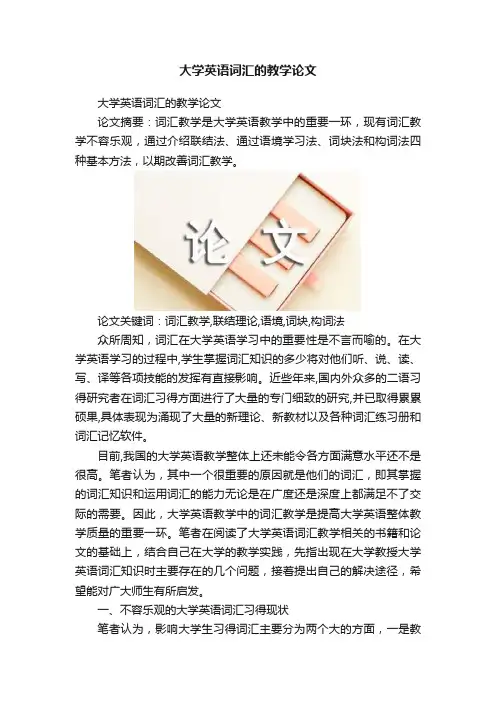
大学英语词汇的教学论文大学英语词汇的教学论文论文摘要:词汇教学是大学英语教学中的重要一环,现有词汇教学不容乐观,通过介绍联结法、通过语境学习法、词块法和构词法四种基本方法,以期改善词汇教学。
论文关键词:词汇教学,联结理论,语境,词块,构词法众所周知,词汇在大学英语学习中的重要性是不言而喻的。
在大学英语学习的过程中,学生掌握词汇知识的多少将对他们听、说、读、写、译等各项技能的发挥有直接影响。
近些年来,国内外众多的二语习得研究者在词汇习得方面进行了大量的专门细致的研究,并已取得累累硕果,具体表现为涌现了大量的新理论、新教材以及各种词汇练习册和词汇记忆软件。
目前,我国的大学英语教学整体上还未能令各方面满意水平还不是很高。
笔者认为,其中一个很重要的原因就是他们的词汇,即其掌握的词汇知识和运用词汇的能力无论是在广度还是深度上都满足不了交际的需要。
因此,大学英语教学中的词汇教学是提高大学英语整体教学质量的重要一环。
笔者在阅读了大学英语词汇教学相关的书籍和论文的基础上,结合自己在大学的教学实践,先指出现在大学教授大学英语词汇知识时主要存在的几个问题,接着提出自己的解决途径,希望能对广大师生有所启发。
一、不容乐观的大学英语词汇习得现状笔者认为,影响大学生习得词汇主要分为两个大的方面,一是教师,二是学生本身。
首先,现在大学英语词汇教学还存在很多的问题。
在一些学校的英语教学中,教师处理词汇的方法还是很死板枯燥。
尽管大学英语教学大纲和教材上都有相关的明确要求,但很多教师观念没有更新,仍然只是机械地带读单词的发音、讲解其拼写和意思,甚至就一个单词,可以写上一黑板的例句。
这种完全按照课本教单词的单一方式完全没有效率,没有培养学生思维和联想的能力,也不利于学生记忆和掌握单词的用法。
其次,很多学生没有掌握科学的记忆单词的方法。
笔者在教学过程中,经常听到有学生反映,认为自己在大学阶段词汇量的几乎没有增加,不仅很难记住生词或者记了很快就忘,甚至于把中学学过的很多单词也忘记了。

英语教师词汇教学论文3篇第一篇直观教学方法是指在教学过程中,教师利用图片、玩具、模型等一系列的实物作为辅助教具,或者通过一些动作、手势和表情等方式来展开教学。
当今,随着网络信息技术的飞速发展,教师能够充分地利用网络、信息、视频、声像等技术,展开直观英语教学。
如此的教学方法有利于学生从感觉直观上对单词实行初步的感知与理解,增强学生的表象记忆,使得学生一开始就能够将事物、动作和感觉等与英语词汇联系在一起。
此种教学方法适合应用于具体的事物名词、感情词汇、动作词汇、感觉词汇等等。
(二)注重词汇语境教学法语境在语言学习中起着至关重要的作用,语言只有处在一定语境之中才有意义,脱离了一定的语境,随之其语义也会发生巨大的变化。
为此,在词汇教学中必须对词汇的适用语境给予高度的注重与重视。
一方面,教师在词汇教学中,要使得学生懂得语境的重要性。
每个词汇都有其适用的语境,在一定的语境之中具有某种语义。
不过,脱离了该语境,便会产生其他的语义。
为此,学生词汇学习要坚持“词不离句,句不离文”的原则,在不同的语境之中对词汇实行揣测、理解和感悟,从而对相关的单词得出准确合理的解释。
另一方面,教师在词汇教学之中,也要重视语境教学法。
在课堂词汇讲解中,尽力将所教的词汇带入相关的语境之中。
使得学生能够较为全面地理解该词汇的语义和内涵,以及其相关的使用方法。
与此同时,教师也能够通过词汇的语境,对某些词汇的意义实行区分,从而消除词汇的歧义。
例如,对于still不同语义的解释。
例1.ThegirlkeptstillinthechairwatchingbasketballgamesonTV.例2.It’swarmtoday,butitwillbestillcoldertomorrow.例3.Mygrandmothersarestillliving,andtheyareveryhealthy.在例1中,still是“不动的、静止的”的意思;在例2中,still是“要还要”的意思;不过在例3中则是“仍旧、还”的意思。
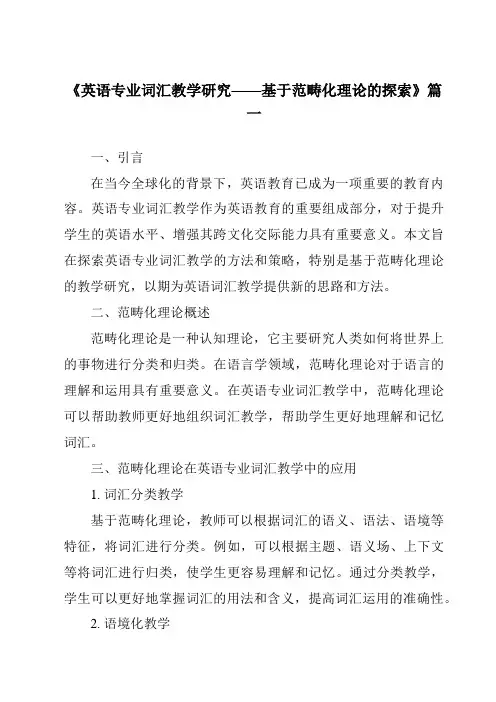
《英语专业词汇教学研究——基于范畴化理论的探索》篇一一、引言在当今全球化的背景下,英语教育已成为一项重要的教育内容。
英语专业词汇教学作为英语教育的重要组成部分,对于提升学生的英语水平、增强其跨文化交际能力具有重要意义。
本文旨在探索英语专业词汇教学的方法和策略,特别是基于范畴化理论的教学研究,以期为英语词汇教学提供新的思路和方法。
二、范畴化理论概述范畴化理论是一种认知理论,它主要研究人类如何将世界上的事物进行分类和归类。
在语言学领域,范畴化理论对于语言的理解和运用具有重要意义。
在英语专业词汇教学中,范畴化理论可以帮助教师更好地组织词汇教学,帮助学生更好地理解和记忆词汇。
三、范畴化理论在英语专业词汇教学中的应用1. 词汇分类教学基于范畴化理论,教师可以根据词汇的语义、语法、语境等特征,将词汇进行分类。
例如,可以根据主题、语义场、上下文等将词汇进行归类,使学生更容易理解和记忆。
通过分类教学,学生可以更好地掌握词汇的用法和含义,提高词汇运用的准确性。
2. 语境化教学语境化教学是范畴化理论在英语专业词汇教学中的另一个重要应用。
教师可以根据词汇的语境,创设真实的语言环境,让学生在真实的语境中学习和运用词汇。
这样不仅可以提高学生的词汇运用能力,还可以增强学生的语感,提高学生的英语水平。
3. 词汇联想教学词汇联想教学是范畴化理论在英语专业词汇教学中的另一种教学方法。
教师可以引导学生根据词汇的语义、语音、形状等特征进行联想,帮助学生建立词汇之间的联系,形成词汇网络。
这样可以帮助学生在记忆词汇时形成联想记忆,提高记忆效果。
四、基于范畴化理论的英语专业词汇教学实践1. 实践案例一:主题式词汇教学主题式词汇教学是一种基于范畴化理论的词汇教学方法。
教师可以根据某个主题,将相关的词汇进行归类和整合,形成一个主题式的词汇表。
通过主题式词汇教学,学生可以更好地理解和记忆相关词汇,提高词汇的运用能力。
2. 实践案例二:情境式教学材料的应用情境式教学材料是一种将真实语言环境融入到教学中的教学资源。
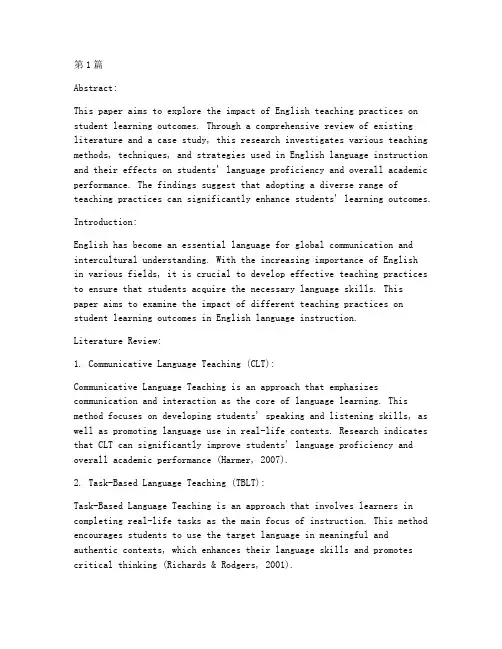
第1篇Abstract:This paper aims to explore the impact of English teaching practices on student learning outcomes. Through a comprehensive review of existing literature and a case study, this research investigates various teaching methods, techniques, and strategies used in English language instruction and their effects on students' language proficiency and overall academic performance. The findings suggest that adopting a diverse range of teaching practices can significantly enhance students' learning outcomes.Introduction:English has become an essential language for global communication and intercultural understanding. With the increasing importance of Englishin various fields, it is crucial to develop effective teaching practices to ensure that students acquire the necessary language skills. This paper aims to examine the impact of different teaching practices on student learning outcomes in English language instruction.Literature Review:1. Communicative Language Teaching (CLT):Communicative Language Teaching is an approach that emphasizes communication and interaction as the core of language learning. This method focuses on developing students' speaking and listening skills, as well as promoting language use in real-life contexts. Research indicates that CLT can significantly improve students' language proficiency and overall academic performance (Harmer, 2007).2. Task-Based Language Teaching (TBLT):Task-Based Language Teaching is an approach that involves learners in completing real-life tasks as the main focus of instruction. This method encourages students to use the target language in meaningful and authentic contexts, which enhances their language skills and promotes critical thinking (Richards & Rodgers, 2001).3. Technology-Enhanced Language Learning (TELL):Technology-Enhanced Language Learning incorporates various technological tools and resources into language instruction to facilitate learning. Research suggests that TELL can enhance students' motivation, engagement, and language proficiency (Svensson, 2012).4. Cooperative Learning:Cooperative Learning is an instructional strategy that encourages students to work together in groups to achieve common goals. This approach promotes communication, collaboration, and critical thinking skills, which are essential for language learning (Johnson & Johnson, 1999).5. Flipped Classroom:The Flipped Classroom model involves students watching instructional videos at home and completing assignments in the classroom. This approach allows teachers to focus on individualized instruction and practice, which can improve students' learning outcomes (Bergmann & Sams, 2012).Case Study:A case study was conducted in a public high school in China to examine the impact of various teaching practices on student learning outcomes. The study involved 60 students from a 10th-grade English class, who were randomly assigned to two groups: an experimental group and a control group. The experimental group received instruction based on the Communicative Language Teaching approach, while the control group received traditional grammar-based instruction.Data were collected through pre-test and post-test scores, student surveys, and teacher observations. The results showed that the experimental group had significantly higher language proficiency and academic performance compared to the control group. Additionally, students in the experimental group reported higher levels of engagement, motivation, and satisfaction with the learning process.Discussion:The findings of this study suggest that adopting diverse teaching practices, such as Communicative Language Teaching, Task-Based Language Teaching, Technology-Enhanced Language Learning, Cooperative Learning, and Flipped Classroom, can significantly enhance student learning outcomes in English language instruction. These methods promote communication, collaboration, critical thinking, and engagement, which are essential for language learning.Conclusion:In conclusion, this paper has explored the impact of English teaching practices on student learning outcomes. The findings indicate that adopting a variety of teaching methods and strategies can significantly improve students' language proficiency and overall academic performance. Educators should consider integrating these practices into their instruction to create a more effective and engaging learning environment for their students.References:Bergmann, J., & Sams, A. (2012). Flip your classroom: Reach every student in every class every day. ISTE.Harmer, J. (2007). The practice of English language teaching (4th ed.). Essex: Pearson Education Limited.Johnson, D. W., & Johnson, R. T. (1999). Learning together and alone: Cooperative, competitive, and individual learning (5th ed.). Boston: Allyn & Bacon.Richards, J. C., & Rodgers, T. S. (2001). Approaches and methods in language teaching (2nd ed.). Cambridge: Cambridge University Press.Svensson, L. (2012). Technology-enhanced language learning: Integrating technology into language teaching and learning. London: Continuum.第2篇Abstract:This paper presents a case study of an English language teachingpractice implemented in a secondary school in China. The study aims to explore the effectiveness of interactive teaching methods in enhancing students' English language learning outcomes. The paper discusses the implementation of various interactive techniques, the challenges faced by both teachers and students, and the overall impact on students' language proficiency and motivation. Findings indicate that interactive teaching practices significantly improve students' engagement and performance in English language learning.Introduction:English language proficiency is increasingly recognized as an essential skill in the globalized world. However, traditional teaching methods often focus on teacher-centered approaches, which may lead to students' passive participation and low achievement. To address this issue, this study investigates the effectiveness of interactive teaching practices in enhancing English language learning outcomes.Literature Review:Interactive teaching methods have been widely recognized as effective in promoting student engagement and learning outcomes. Research indicates that interactive techniques such as group work, discussions, and cooperative learning can enhance students' critical thinking, problem-solving skills, and language proficiency (Johnson & Johnson, 1999). Moreover, interactive teaching practices can also foster a positive learning environment, where students feel more motivated and confident in their abilities (Bligh, 2000).Methodology:The study was conducted in a secondary school in China, involving atotal of 60 students from Grade 9. The participants were divided into two groups: the experimental group (n=30) and the control group (n=30). The experimental group received interactive teaching methods, while the control group followed the traditional teacher-centered approach.The interactive teaching practices implemented in the experimental group included group discussions, role-playing, and cooperative learning activities. The activities were designed to promote student interaction, critical thinking, and language proficiency. Additionally, the teacher used various multimedia resources, such as videos, audio clips, and online platforms, to facilitate student engagement.Data collection involved pre-test and post-test scores, students' self-assessment questionnaires, and teacher observations. The pre-test and post-test scores were used to assess the students' language proficiency, while the self-assessment questionnaires and teacher observations provided insights into students' engagement and motivation.Results:The results indicate that the interactive teaching practicessignificantly improved students' language proficiency and engagement in English language learning. The post-test scores of the experimentalgroup were significantly higher than those of the control group (p<0.05). Moreover, the students in the experimental group reported higher levels of motivation and engagement, as evidenced by their self-assessment questionnaires and teacher observations.Discussion:The findings of this study support the effectiveness of interactive teaching practices in enhancing English language learning outcomes. The implementation of group discussions, role-playing, and cooperative learning activities allowed students to actively participate in the learning process, fostering their critical thinking and problem-solving skills. Additionally, the use of multimedia resources and online platforms provided students with a more engaging and interactivelearning experience.However, the study also identified some challenges in implementing interactive teaching practices. Teachers may face difficulties in managing large classes, ensuring that all students are actively participating, and maintaining discipline. Furthermore, students mayinitially struggle with the transition from a teacher-centered to an interactive learning environment.Conclusion:This case study demonstrates that interactive teaching practices can significantly enhance English language learning outcomes. By promoting student engagement, critical thinking, and language proficiency, interactive teaching methods can contribute to a more effective and enjoyable learning experience. Teachers should consider incorporating various interactive techniques into their teaching practices to foster a positive learning environment and improve students' language proficiency.References:Bligh, D. A. (2000). What's the difference? The effect of instruction method on students' learning. ERIC Clearinghouse on Teaching and Teacher Education.Johnson, D. W., & Johnson, R. T. (1999). Learning together and alone: Cooperative, competitive, and individualistic learning (5th ed.). Boston: Allyn & Bacon.第3篇Abstract:This paper presents a case study of an innovative English language teaching (ELT) program implemented in a secondary school in China. The study aims to explore the effectiveness of various teaching strategies and methods in improving students' English proficiency and language skills. Through a mixed-methods approach, including surveys, interviews, and classroom observations, this paper analyzes the impact of the program on students' learning outcomes, teachers' perceptions, andoverall classroom dynamics. The findings suggest that the integration of technology, project-based learning, and personalized instruction significantly enhances the learning experience and academic achievements of students in an ELT context.Introduction:The increasing globalization has emphasized the importance of English language proficiency in education and career development. As a result, English language teaching has become a crucial component of the curriculum in many countries, including China. However, traditional teaching methods, often characterized by teacher-centered approaches and rote learning, have been criticized for their limited effectiveness in fostering students' language skills and critical thinking abilities. This paper investigates the impact of an innovative ELT program on students' language acquisition and learning experiences.Methodology:The study adopted a mixed-methods approach, combining quantitative and qualitative data collection techniques. The participants included 80 students from a secondary school in China, 10 English teachers, and the program coordinators. The data collection methods were as follows:1. Surveys: A self-designed survey was administered to students and teachers to gather information about their perceptions of the program, its effectiveness, and the challenges faced during its implementation.2. Interviews: Semi-structured interviews were conducted with a sample of students, teachers, and program coordinators to gain a deeper understanding of their experiences and insights.3. Classroom Observations: Classroom observations were conducted to analyze the teaching strategies and methods employed by the teachers and their impact on student learning.Results:1. Students' Perceptions: The survey results indicated that students generally had a positive perception of the program. They reported that the innovative teaching methods, such as project-based learning and technology integration, made the learning process more engaging and enjoyable.2. Teachers' Perceptions: Teachers expressed their satisfaction with the program, emphasizing the benefits of technology integration andpersonalized instruction. They highlighted the increased student engagement and improved learning outcomes as significant outcomes of the program.3. Learning Outcomes: The analysis of classroom observations and students' performance in assessments revealed that the innovative ELT program had a positive impact on students' language acquisition and skills. Students demonstrated improved speaking, listening, reading, and writing abilities.4. Classroom Dynamics: The implementation of the program fostered a more interactive and student-centered classroom environment. Studentsactively participated in discussions, group activities, and technology-based tasks, which enhanced their critical thinking and collaborative skills.Discussion:The findings of this study suggest that innovative ELT programs, such as the one implemented in this case study, can significantly enhance students' language proficiency and learning experiences. The integration of technology, project-based learning, and personalized instruction has been found to be effective in fostering students' critical thinking abilities, collaboration skills, and engagement in the learning process.The study also highlights the importance of teacher training and professional development in implementing innovative teaching strategies. Teachers should be equipped with the necessary skills and knowledge to adapt to new teaching methods and technologies.Conclusion:This case study demonstrates the positive impact of an innovative ELT program on students' language acquisition and learning experiences. The integration of technology, project-based learning, and personalized instruction has proven to be effective in enhancing students' English proficiency and language skills. The findings of this study can provide valuable insights for educators and policymakers in designing and implementing effective ELT programs.Keywords: English language teaching, innovative practices, technology integration, project-based learning, personalized instruction, student learning outcomes。
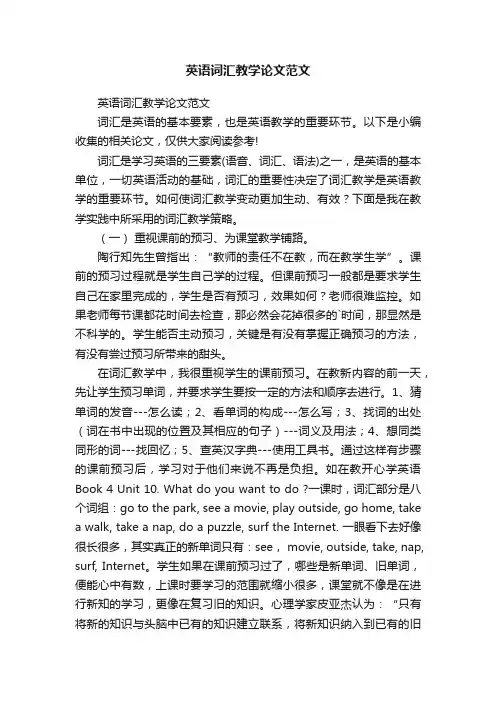
英语词汇教学论文范文英语词汇教学论文范文词汇是英语的基本要素,也是英语教学的重要环节。
以下是小编收集的相关论文,仅供大家阅读参考!词汇是学习英语的三要素(语音、词汇、语法)之一,是英语的基本单位,一切英语活动的基础,词汇的重要性决定了词汇教学是英语教学的重要环节。
如何使词汇教学变动更加生动、有效?下面是我在教学实践中所采用的词汇教学策略。
(一)重视课前的预习、为课堂教学铺路。
陶行知先生曾指出:“教师的责任不在教,而在教学生学”。
课前的预习过程就是学生自己学的过程。
但课前预习一般都是要求学生自己在家里完成的,学生是否有预习,效果如何?老师很难监控。
如果老师每节课都花时间去检查,那必然会花掉很多的`时间,那显然是不科学的。
学生能否主动预习,关键是有没有掌握正确预习的方法,有没有尝过预习所带来的甜头。
在词汇教学中,我很重视学生的课前预习。
在教新内容的前一天,先让学生预习单词,并要求学生要按一定的方法和顺序去进行。
1、猜单词的发音---怎么读;2、看单词的构成---怎么写;3、找词的出处(词在书中出现的位置及其相应的句子)---词义及用法;4、想同类同形的词---找回忆;5、查英汉字典---使用工具书。
通过这样有步骤的课前预习后,学习对于他们来说不再是负担。
如在教开心学英语Book 4 Unit 10. What do you want to do ?一课时,词汇部分是八个词组:go to the park, see a movie, play outside, go home, take a walk, take a nap, do a puzzle, surf the Internet. 一眼看下去好像很长很多,其实真正的新单词只有:see, movie, outside, take, nap, surf, Internet。
学生如果在课前预习过了,哪些是新单词、旧单词,便能心中有数,上课时要学习的范围就缩小很多,课堂就不像是在进行新知的学习,更像在复习旧的知识。
第1篇Introduction:Vocabulary is a crucial component of language learning, and an effective vocabulary class can significantly enhance students' language proficiency. This essay presents a teaching practice of an English vocabulary class, focusing on innovative methods and strategies that promote student engagement and retention. The class is designed for intermediate-level learners, and the content includes a variety of vocabulary topics relevant to their interests and needs.I. Pre-class Preparation1. Identify vocabulary topics: Before the class, the teacher selects vocabulary topics based on the students' interests, current events, and curriculum objectives. For this session, the topic is "Travel and Tourism."2. Create a vocabulary list: The teacher compiles a list of essential vocabulary words related to the topic, ensuring a mix of common and less common words.3. Prepare teaching materials: The teacher gathers various teaching materials, such as pictures, videos, and real-life examples, tofacilitate learning and make the class interactive.II. Class Structure1. Introduction (5 minutes)- The teacher introduces the topic and its relevance to the students' lives.- A brief overview of the vocabulary list is provided.2. Vocabulary Introduction (10 minutes)- The teacher uses pictures, videos, and real-life examples to present the vocabulary words.- Students are encouraged to guess the meanings of new words based on the context.3. Group Work (15 minutes)- Students are divided into small groups and given a set of vocabulary cards.- Each card contains a word and its definition. The groups work together to match the words with their definitions.- The teacher circulates among the groups, providing guidance and answering questions.4. Interactive Games (15 minutes)- The teacher introduces interactive games, such as "Word Search," "Guess the Word," and "Vocabulary Charades," to reinforce the learning.- Students actively participate in these games, enhancing their understanding of the vocabulary words.5. Role Play (10 minutes)- The teacher creates a scenario related to the topic, and students work in pairs or small groups to role-play the situation.- This activity allows students to practice using the vocabulary words in a real-life context.6. Writing Exercise (10 minutes)- The teacher provides a short writing prompt related to the topic.- Students write a short paragraph using the new vocabulary words, demonstrating their understanding and retention.7. Class Review (5 minutes)- The teacher revisits the vocabulary list and reviews any difficult words.- Students are encouraged to ask questions and clarify their doubts.III. Assessment and Feedback1. Formative assessment: Throughout the class, the teacher observes students' participation, engagement, and understanding of the vocabulary words.2. Summative assessment: At the end of the class, the teacher collects the writing exercises to assess the students' retention of the new vocabulary.3. Feedback: The teacher provides individual and group feedback on the writing exercises, highlighting strengths and areas for improvement.Conclusion:This teaching practice of an English vocabulary class demonstrates the importance of incorporating various methods and strategies to promote student engagement and retention. By using pictures, videos, interactive games, and real-life examples, the teacher encourages students to actively participate in the learning process. Additionally, theinclusion of role play and writing exercises helps students practice using the vocabulary words in different contexts. Overall, this teaching practice aims to create an interactive and enjoyable learning environment that fosters long-term vocabulary acquisition.第2篇Introduction:Vocabulary is a crucial component of language learning, as it provides the foundation for effective communication. In this teaching practice, I will outline a comprehensive approach to conducting an English vocabulary class, focusing on interactive and engaging activities that promote active learning and long-term retention of vocabulary.I. Pre-Session Preparation1. Course objectives:Before the session, it is essential to define clear objectives for the vocabulary class. These objectives should align with the overall goals of the course and include specific vocabulary themes or topics.2. Vocabulary selection:Select a variety of vocabulary words that are relevant to the students' interests and level of proficiency. Consider using a mix of everyday words, academic terms, and specialized vocabulary from different fields.3. Learning materials:Prepare a list of vocabulary words, their definitions, synonyms, antonyms, and example sentences. Additionally, gather supplementary materials such as images, videos, and real-life examples to enhance understanding.II. Introduction (5 minutes)1. Warm-up activity:Start the class with a brief warm-up activity to engage the students' attention and review previously learned vocabulary. This could be a quick game, such as "Find the synonym" or "Fill in the blanks."2. Introduction to the new vocabulary:Introduce the new vocabulary words by displaying them on the board or using an interactive whiteboard. Provide a brief definition and pronunciation guide for each word.III. Vocabulary Exploration (20 minutes)1. Group work:Divide the class into small groups and assign each group a set of vocabulary words. Provide them with a worksheet that includes tasks such as defining the words, creating sentences, and finding synonyms and antonyms.2. Interactive games:Organize interactive games that encourage students to use the new vocabulary in different contexts. Examples include "Vocabulary Charades," "Word Search," and "Vocabulary Bingo."3. Role-playing:Encourage students to engage in role-playing activities that require them to use the new vocabulary in a real-life context. This can help reinforce their understanding and improve their confidence in using the words.IV. Practice and Application (15 minutes)1. Writing exercises:Provide students with writing prompts that require them to use the new vocabulary. This could be a short paragraph, an email, or a blog post.2. Oral practice:Conduct a group discussion or a debate where students can use the new vocabulary to express their opinions and ideas.V. Review and Feedback (10 minutes)1. Vocabulary review:Conclude the class with a quick review of the new vocabulary. Use a variety of activities, such as "True or False" questions, "Which word fits?" and "Match the word with its definition."2. Feedback:Encourage students to provide feedback on the class, including what they found helpful and what they would like to see improved in future sessions.VI. Post-Session Activities1. Homework:Assign a homework task that reinforces the new vocabulary, such as writing a short essay or creating a presentation using the words.2. Online resources:Provide students with access to online resources, such as vocabulary apps, websites, and forums, where they can continue learning and practicing the new words.Conclusion:This practical teaching approach to English vocabulary class emphasizes active learning, engagement, and long-term retention. By incorporating a variety of activities and resources, students are more likely to develop a strong vocabulary foundation that will support their language learning journey. Remember to adapt and adjust the activities based on the specific needs and preferences of your students for the best learning experience.第3篇IntroductionEffective vocabulary instruction is crucial for language learners, as it forms the foundation for communication and comprehension. This paper presents a practical teaching approach to English vocabulary classes, focusing on innovative methods and strategies that enhance student engagement and retention. The approach is designed to be adaptable to different learning styles and levels, ensuring that all students can benefit from the session.I. Lesson PlanningA. ObjectivesBefore designing a vocabulary lesson, it is essential to establish clear objectives. For this lesson, the following objectives are set:1. Students will be able to recognize and use new vocabulary in context.2. Students will develop strategies for memorizing and retaining new words.3. Students will improve their ability to use new vocabulary in sentences and conversations.B. MaterialsThe following materials are required for the lesson:1. Vocabulary list with definitions and usage examples.2. Interactive whiteboard or projector for displaying visuals and activities.3. Handouts or worksheets for students to practice and review vocabulary.4. Digital resources such as apps, videos, and online dictionaries.II. Warm-Up ActivityA. Group DiscussionTo begin the lesson, start with a brief group discussion to engage students and activate prior knowledge. Ask students to share their experiences with learning new vocabulary and any challenges they may have faced.B. Vocabulary GameIntroduce a fun and interactive game that encourages students to use their new vocabulary. For example, you can play a game of "Word Association" where students must provide synonyms or antonyms for given words.III. Introduction to New VocabularyA. PresentationPresent the new vocabulary using a variety of methods to cater to different learning styles:1. Visuals: Use images, videos, or flashcards to illustrate the meanings of the new words.2. Contextual Usage: Provide examples of sentences using the new vocabulary to demonstrate proper usage.3. Academic Discourse: If applicable, explain any specific context or field in which the vocabulary is commonly used.B. Group WorkDivide students into small groups and assign them a task related to the new vocabulary. For instance, they can create a mind map of the new words, write a short paragraph using the vocabulary, or design a game to teach the words to their peers.IV. Practice ActivitiesA. Matching GameCreate a matching activity where students must match the new vocabulary words with their definitions. This can be done in pairs or small groups, and can be adapted for different levels of difficulty.B. Sentence BuildingAsk students to form sentences using the new vocabulary, focusing on different sentence structures. This activity can be done individually or in groups, and can be graded based on the complexity and accuracy of the sentences.C. Role-PlayingEncourage students to engage in role-playing scenarios that require the use of the new vocabulary. This activity helps students practice real-life contexts and can be particularly beneficial for learners of English as a second language.V. Review and ReflectionA. Group ReviewConduct a group review session where students share their experiences and insights from the lesson. Discuss any difficulties they encountered and brainstorm strategies for overcoming them.B. Reflection ActivityAssign a reflection activity for students to complete after the lesson. This could be a short essay, a journal entry, or a presentation on how they plan to use the new vocabulary in their daily lives.ConclusionThis practical teaching approach to English vocabulary classes aims to provide a dynamic and engaging learning experience for students. By incorporating a variety of activities and strategies, the lesson encourages students to actively participate, retain new vocabulary, and apply it in real-life situations. As language educators, it is our responsibility to adapt our teaching methods to meet the diverse needs of our students, and this approach serves as a valuable tool in achieving that goal.。
基于语料库的大学英语词汇教学摘要:大学英语课程教学的主要目的是培养学习者使用英语进行交际的能力。
基于对语料库的研究,本文针对英语学习者在使用英语词汇时常见的错误分析,探讨将其应用于大学英语词汇教学实践,旨在帮助学生真正掌握英语词汇知识,提高学生的英语词汇实际运用能力,同时增强其自主学习能力,培养和提高学生英语听、说、读、写、译综合应用能力。
关键词:语料库英语教学大学英语词汇教学1.引言在教学过程中, 作者发现学生在使用英语进行口头或书面交际时常常会用错词, 例如:(1)in time he will see who is his real (true) friend,(2)the sun is raising (rising) in the east, (3)i can say (speak) english,(4)to increase(improve) my english, i often buy many books,(5)the book is very well (good) 等等。
从以上学生误用英语词汇的实际例子可以看出:(1) 学生对英语词汇意义不能准确掌握,(2)学生不能正确使用英语词汇。
大学英语教学离不开英语词汇的教学环节。
wilkins对于词汇在语言习得中的重要性有句精辟的论断:“没有语法,很多东西难以表达;而没有词汇则什么也表达不了”。
sinclair早在20世纪80年代末期就提出外语教学可以从学习词汇入手。
他认为以往的词汇教学仅仅是语法教学的附属品,词的选择没有代表性和科学性。
他和同事联合调查类套对外英语教材(efl course books),发现教科书中普遍存在脱离词的实际用法和使用价值而孤立谈词汇的现象。
在我国的大学英语教学中,我们常常听到学生抱怨他们的词汇量太少,限制了他们的听说和写作能力。
词汇量少固然是一个问题,但我们发现许多学生的词汇量很大,却依旧有交流的困难,我们认为这其中一个问题就是,怎样去学习词汇。
第1篇一、引言词汇是语言的基础,是语言学习的核心内容。
词汇教学是语言教学的重要组成部分,对于提高学生的语言运用能力具有重要意义。
本文将从词汇教学的理论基础、教学方法、教学策略和教学评价等方面,探讨词汇教学实践。
二、词汇教学理论基础1. 认知心理学理论认知心理学理论认为,词汇学习是一个动态的、多阶段的、复杂的心理过程。
学习者通过感知、理解、记忆、运用等环节,逐步掌握词汇。
词汇教学应注重培养学习者的认知能力,提高其词汇学习效果。
2. 语言习得理论语言习得理论强调语言学习是一个自然的过程,学习者通过接触、模仿、实践等方式,逐步习得语言。
词汇教学应注重创设真实的语言环境,让学习者通过语言实践来掌握词汇。
3. 社会文化理论社会文化理论认为,语言是文化的一部分,语言学习是一个社会文化的过程。
词汇教学应注重培养学习者的跨文化交际能力,提高其语言运用水平。
三、词汇教学方法1. 词汇对比法词汇对比法通过对同义词、反义词、近义词等词汇进行对比,帮助学生更好地理解词汇的意义和用法。
例如,在教学“happy”和“glad”时,可以引导学生对比两者的用法和语境。
2. 词汇归纳法词汇归纳法通过对词汇进行分类、归纳,帮助学生发现词汇之间的规律,提高词汇学习效率。
例如,在教学名词时,可以引导学生归纳名词的分类和用法。
3. 词汇扩展法词汇扩展法通过对核心词汇进行扩展,帮助学生掌握更多相关词汇。
例如,在教学“travel”时,可以引导学生扩展出“traveler”、“traveling”、“travel agency”等词汇。
4. 词汇实践法词汇实践法通过让学生在真实的语言环境中运用词汇,提高其词汇运用能力。
例如,在课堂讨论、角色扮演等活动中,教师可以引导学生运用所学词汇。
四、词汇教学策略1. 词汇语境化策略词汇语境化策略强调在具体的语境中学习词汇,帮助学生更好地理解词汇的意义和用法。
教师可以通过创设真实的语言环境,让学生在实际语境中运用词汇。
大学英语词汇教学论文一大学英语词汇教学的问题与不足目前的大学英语词汇教学的形式比较单一,教师对于词汇的讲授方法还只停留在发音、词汇构成和字面意义上。
通常在上课时,教师仅从头到尾领读一遍单词,矫正学生的发音,然后为学生讲解单词的词缀结构和表层含义。
整个词汇教学并没有把跨文化交际意识融入到单词讲解中,对词源缺乏系统的讲解,对词汇的引申含义没有过多的涉猎。
然而,跨文化交际的能力培养是十分重要的,这项能力被列为外语学习的主要内容之一。
早在2007年教育部颁布的《大学英语课程教学要求》中就已提出,“大学英语是以外语教学理论为指导,以英语语言知识与应用技能、跨文化交际和学习策略为主要内容,并集多种教学模式和教学手段为一体的教学体系。
在词汇教学中,忽视了对学生跨文化交际能力的培养会产生很多问题,导致词汇误用或误解的现象频发。
二词汇与文化的关系语言作为文化的载体,不能脱离文化范畴而单独存在。
而词汇又是构成语言的基础单位,词汇的不同排列组合可以体现不同的文化内涵。
词汇,又称语汇,是一种语言里所有的(或特定范围的)词和固定短语的总和。
有些词汇具有全球共性,无论在任何语种内都指代某种特定的物件,它的文化性与独特性不突出,这样的词汇是非文化词汇(non-culturalvocabu-lary),如pencil,table,flower等,在任何语种中都能找到相对应的词汇。
但还有相当一部分词汇是在一个地区、国家或民族特有的文化现象中产生或经过其领域内重大事件的引用而产生新的对此重大事件有代表性的词汇,我们把这种词汇称为文化词汇(culturalvocabulary),如Americandream,bloodyMarry 等。
因此,大学英语教学必须从多个层次进行,在帮助学生了解语音和语法的基础上,还要强调文化导入的语义教学,单词的讲解除了其字面意思之外,更要有适度的扩充与延伸。
由于英语词汇和汉语词汇的含义大多不能完全对应,文化词汇占大多数,因此在词汇教学中必须融入跨文化交际意识才能让学生对单词的内涵、使用范畴、交际习惯和交际规约等有更加全面的把握。
第1篇摘要随着全球化的不断深入,英语作为国际通用语言的重要性日益凸显。
大学英语作为高等教育阶段的一门基础课程,对于提高学生的英语水平具有重要意义。
单词是语言的基础,掌握一定数量的词汇是学习英语的关键。
本文通过对大学英语单词教学的实践研究,分析当前教学中存在的问题,并提出相应的改进策略,以期为提高大学英语单词教学效果提供参考。
一、引言大学英语单词教学是大学英语课程的重要组成部分,对于提高学生的英语阅读、写作、听力、口语等综合能力具有基础性作用。
然而,在实际教学中,由于教学方法、学生学习态度等多种因素的影响,大学英语单词教学效果并不理想。
本文通过对大学英语单词教学的实践研究,探讨如何提高教学效果,以期为英语教学工作者提供有益的参考。
二、当前大学英语单词教学中存在的问题1. 教学方法单一在大学英语单词教学中,部分教师仍然采用传统的讲授法,以教师讲解为主,学生被动接受。
这种教学方法忽视了学生的主体地位,导致学生参与度不高,学习效果不佳。
2. 词汇学习缺乏兴趣由于大学英语单词数量庞大,部分学生对于单词学习缺乏兴趣,认为单词记忆枯燥乏味,导致学习效果不佳。
3. 词汇教学与实际应用脱节部分教师在教学中过于注重词汇的记忆,忽视了词汇在实际语境中的应用。
这使得学生在面对实际问题时,往往无法运用所学词汇进行表达。
4. 评价方式单一在大学英语单词教学中,部分教师仅通过课堂提问、课后作业等方式进行评价,评价方式单一,难以全面反映学生的学习情况。
三、改进大学英语单词教学的策略1. 采用多元化的教学方法教师应结合学生的实际情况,采用多元化的教学方法,如情境教学法、任务型教学法、合作学习法等,提高学生的学习兴趣和参与度。
2. 培养学生的学习兴趣教师应注重激发学生的学习兴趣,通过游戏、故事、多媒体等多种形式,让学生在轻松愉快的氛围中学习单词。
3. 强化词汇在实际语境中的应用教师应注重词汇在实际语境中的应用,通过创设真实语境,让学生在实际交流中运用所学词汇,提高学生的英语实际运用能力。
第1篇一、引言词汇是语言的基础,是语言表达和沟通的基石。
在英语教学中,词汇教学占有举足轻重的地位。
然而,传统的词汇教学模式往往过于枯燥,难以激发学生的学习兴趣。
为了提高词汇教学的效果,我们需要探索新的词汇实践教学方法。
本文将从以下几个方面探讨词汇实践教学的方法和策略。
二、词汇实践教学的意义1. 提高学生学习兴趣词汇实践教学通过多种教学手段,如游戏、活动、故事等,使学生在轻松愉快的氛围中学习词汇,从而激发学生的学习兴趣。
2. 培养学生词汇运用能力词汇实践教学注重培养学生的词汇运用能力,使学生在实际语境中掌握词汇的用法,提高语言表达能力。
3. 促进学生语言综合素质的提高词汇实践教学关注学生的全面发展,不仅提高学生的词汇水平,还能培养学生的思维能力、创新能力和合作能力。
三、词汇实践教学的方法1. 游戏化教学游戏化教学是一种以游戏为载体,将游戏元素融入教学过程的教学方法。
在词汇教学中,教师可以设计一些有趣的词汇游戏,如“单词接龙”、“猜单词”等,让学生在游戏中学习词汇。
2. 情境教学情境教学是一种以情境为背景,让学生在特定的语境中学习词汇的教学方法。
教师可以根据教学内容,创设真实的语言情境,让学生在实际语境中运用词汇。
3. 任务型教学任务型教学是一种以任务为导向,让学生在完成任务的过程中学习词汇的教学方法。
教师可以设计一些与生活、工作相关的任务,让学生在完成任务的过程中学习词汇。
4. 合作学习合作学习是一种以学生为主体,通过小组合作完成任务的教学方法。
在词汇教学中,教师可以将学生分成小组,让他们共同完成词汇学习任务,提高学生的学习效果。
5. 多媒体教学多媒体教学是一种利用多媒体技术辅助教学的教学方法。
教师可以利用多媒体课件、网络资源等,为学生提供丰富的词汇学习材料,提高学生的学习兴趣。
四、词汇实践教学的具体实施策略1. 设计丰富多样的教学活动教师可以根据教学内容,设计丰富多样的教学活动,如词汇竞赛、角色扮演、小组讨论等,让学生在活动中学习词汇。
大学英语词汇教学的探索与实践摘要:词汇是学习语言的基本,没有大量的词汇最保障,就很难掌握语言的学习,掌握词汇的要注意词汇的”质”和”量”。
掌握正确的方法,学习起来就比较轻松。
大学英语教学中,英语教师应该注意现在英语词汇的教学现状,使用不同的方法提高学生的英语词汇。
关键词:大学英语教学现状策略
中图分类号:g420
任何语言都是有大量的词汇、语法、语音组成的,其中词汇是基本的构成要素。
学习语言就像盖大楼一样,词汇就是这种大楼所用的材料,例如砖头、混凝土、钢筋,都是些最常用、最活跃的部分。
英国的语言家说过:”没有语法,人们表达的事物寥寥无几,而没有词汇,人们则无法表达任何事物。
这充分说明了词汇的重要性。
因此,词汇教学理应成为英语教学中的一个极其重要的环节.大学英语课应该以词汇为中心,引导学生去学习词的主要惯用法、词的不同语法形式在表达意义上的特点等.如何使学生有效地掌握更多的词汇乃是整个外语教学的中心议题之一。
在大学英语学习中,掌握词汇的多少一种是评价学生掌握英语的一种重要的标志。
1、大学英语词汇的教学现状
对于语言者的学习,词汇的掌握这是最基本的事情,但是学习词汇又是最难得事情,也是学生不愿意去学习的事情,学习词汇感觉是最耗时间、效率也是最低的。
这种死记硬背并没有使他们的词
汇量真正的扩大。
很多学生是根据每片英文课文后面的词汇来背的,有些学生是根据四、六级的词汇来掌握的,还多去看看四六级的词典。
这种方式的记性效率是最低的也是没有很大效果的,单纯的通过单词表记忆脱离词汇应用的实际语境,只能是枯燥的机械记忆,使得单词的记性只能在大脑里停留很短的时间,过一点时间就会忘掉一大半,这也是符合人的机型曲线的,同时也很大打击了学生的成就感,让学生在记忆单词中很难学习到新的单词,对单词产生一定的厌恶感。
也不能更好地学习词汇。
多数的学生学习单词的过程中,并没有搞明白单词的词性,不能很好地通过一定的归类来记忆,例如不明白那些是形容词,那些是副词、那些是动词,那些是积极词汇、那些是消极词汇,那些是中性词汇。
很多学生学习词汇缺乏一定的系统性,没有掌握学习词汇的规律,不能根据记忆曲线来对词汇进行记忆,不能了解词汇的构成规律,对前缀、后缀的意义不了解、这些都很不助于学生学习语言中的词汇,更不利于语言的交际能力的培养。
多年来,受结构语言学的影响,英语的教学方式太强调语言的结构和语言的形式,一定程度上忽视了词汇的教学,大学英语课上很多老师都重在培养学生的语篇能力的培养,重在学生听、说、读的能力,导致不能让学生更好地去学习词汇,也没有养成学习词汇的好方法。
由于词汇的数量很多,学生没有正确的方式去学习,也没有系统的去学习,只能是机械的记忆,这种方式严重影响着学生学习英语的积极性和信心。
因此教师在课堂的教学中应该不能简
单的讲解词汇的意思,应该多去指导学生学习英语的方法,从记忆的策略上去指导学生。
2、大学英语词汇教学的重要策略
2.1突出语境教学
语言学家吕叔湘先生曾说:”词语要嵌在上下文里头才有生命,才容易记住,才知道用法”。
学生应该通过文章中词汇的语境,充分了解上下文的意思,对词汇进行合理的猜测,得出词汇正确的意识,联系语境之间的关系,从而得出单词的意思。
学生要把记忆的单词应用到具体的具体的例子中,放到具体的文章中,通过语境之间的联系来加深对词汇的理解,这样的记性不仅准确还牢固。
2.2强调构词法.运用联想归纳法记忆词汇
英语中很多的词汇都是原来的词符复合而来的,对于这类复合词,在词汇的学习中,应该吧词汇分解来学习,通过了解各部分的意思在学习这个词就特别的简单,这样学习的单词记忆起来也特别的轻松。
派生词在在简单的词汇上加上词缀比如说前缀或者后缀,赋予词汇新的意思。
这样的词汇在英语单词中特点的常见。
前缀一般是只改变单词的词义,不改变单词的词性。
后缀一般是即改变词性又改变词义。
利用词根、词缀来记忆单词有助于学生学习词汇的扩展。
同义词加上不同的词缀就会得到不同的派生词。
、,不能掌握派生词的规律学习起来就特别的又难度,例如destroy 动词,摧毁,消灭粉碎,派生词,destructive 形容词,破坏的,destruction 名词,破坏,destructiveness名词,破坏程度,破坏能力。
英语
的单词构成的方法很多,同时词组的构成方法也具有很多的规律性,学生在学习英语中应该掌握英语词组的构成规律,通过联想的方法来进行学习,同一个词通过搭配不同的副词或者动词、名词就具有不同的意思。
例如:battle 名词,战役、争斗动词,作战,斗争。
词组有,accept battle应战,迎战,deliver battle 开战,交战 fall in battle阵亡half the battle成功的一半 win the battle 战胜 lose the battle战败。
结束语;
除了上面介绍的几种学习英语的策略,教师还应该注意学生学习词汇中的预习和复习,论语中说,温故而知新。
要注意学生的学习英语单词的听、说、读、写相配合,不能通过单纯的学习英语来提高自己学习英语成绩,要让学生自主的去学习,培养学生自律能力。
教师也可以通过不同的检查词汇的方法,来评估学生学习单词掌握情况,词汇的记忆不仅要掌握单词的数量还要明白单词的不同意思。
单词往往是一词多义,不同的语境中具有不同的意思。
英语学习是一个持续性的过程,要有一定的信心去坚持下去,重在平时的坚持。
词汇的学习是没有捷近的,也不能一蹴而就的。
在词汇教学中,只有充分发挥学生的理解力与联想力,同时创造机会给学生运用所学的词汇,才能全面提高学生的学习效率。
参考文献:
[1]关冕.大学英语词汇教学浅析[j].商品与质量·理论研究,2011,(6):235.
[2]王滨.对大学英语词汇教学的几点思考(四)[j].考试周刊,2011,(41):75-76.
[3]廖燕萍.大学英语词汇教学浅探[j].辽宁经济职业技术学院·辽宁经济管理干部学院学报,2011,(3):103-104.
[4]徐红芳.大学英语词汇教学的探索与实践[j].海外英语(中旬刊),2011,(10):472-473.
[5]贺亚丽.浅谈大学英语词汇教学[j].中国校外教育(理论),2007,(10):13.。